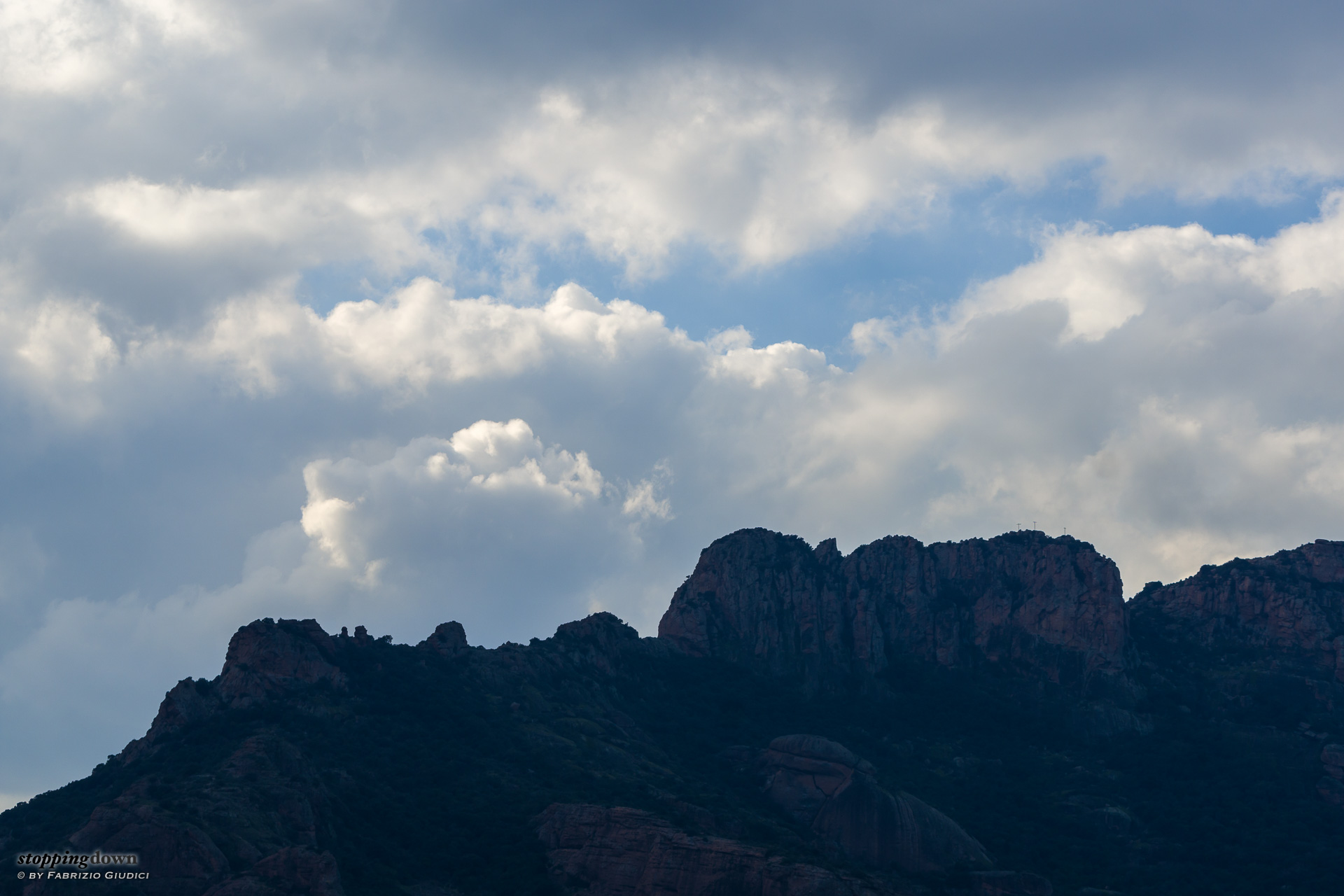February is the month of mimosas. The past year I was able to have a quick appetiser of the explosion of colour brought by those trees and I planned to spend three days this year. Unfortunately, a family emergency disrupted my plans at the last minute. The three days went away, but I anyway tried to have a spare one as soon as the emergency was over (and the weather forecast was fine). But things didn't go as I expected.
Sony α6000 + Sony FE 70-200mm F4 G OSS @ 70 mm, 1/250 sec @ ƒ/8, ISO 100
Rassemblement de nuages sur le Rocher de Roquebrune.
The forecast by Météo France was full sun, with some rain only in the late evening. I counted on the bright sun and blue sky to replicate the chromatic contrast of the past year, hopefully with some more clouds. Unfortunately, there was a quickly changing weather with plenty of clouds, with also a hazy atmosphere. A large cloud shadowed everything for all the time I was in the Tanneron massif, with its plenty of blossoming mimosas; while the landscape appeared to be sunny towards the sea. So I drove there, but I was not satisfied because of the haze. Probably there was also another problem: I didn't feel good. Indeed, in the morning and during the previous day I wasn't really feeling about going for a photographic journey — but having planned the day, I didn't want to give up. The problem with landscapes, for me, is that either I have a glorious scenario or I have to internalise it: it need that it inspires some feeling of some kind. When it works, almost any kind of weather is good. When it doesn't work, no kind of weather is good. For the whole morning it didn't worked. At some point some clouds gathered together and there was also a quick shower, with some gathering clouds over the Rocher de Roquebrune; but it was an exception and the only photo in the morning.
Sony α6000 + Sony FE 70-200mm F4 G OSS @ 70 mm, 1/125 sec @ ƒ/8, ISO 100
Paysage du Plan de Canjuers avec le Mourre de Chanier.
Looking north, the highlands seemed covered by clouds. I figured out some misty atmosphere, so I decided to go up to the Col du Bel Homme. The weather was crazy, indeed: I didn't pass through a layer of fog, nonetheless when I got up to the Plan de Canjuers the northern sky had turned almost completely blue; the air was clear and less haze. It happened that the clouds turned around me and gathered south of the highland.
The Plan de Canjuers is always fascinating, in any season. It is a vast deserted garrigue, only furrowed by the paths used by military tanks of the nearby base. Here and there there were some traces of the snow that had been covering the land only until a few weeks ago. While most places, when the snow melts, are just muddy and unattractive, the Plan de Canjuers is interesting in this season too — maybe it's even at its best, with trees that are still black skeletons and the faraway Prealps still covered with snow. It's definitely a moody place, and at 4:30PM, at last, I started shooting.
Sony α6000 + Sony FE 70-200mm F4 G OSS @ 70 mm, 1/80 sec @ ƒ/8, +0.30 EV, ISO 100
Le château de Bargème.
If you know where to look at, you note that the whole highland is dominated by the small village of Bargème and its castle. Outside the tourist season it's the village of silence: a deep, absolute silence — with possibly the wind as the unique exception.
Sony NEX-6 + Sony Zeiss Vario-Tessar T* E 16-70mm F4 ZA OSS @ 26 mm, 1/50 sec @ ƒ/13, ISO 100
La Chapelle Notre-Dame-de-Gratemoine à Séranon.
Sony NEX-6 + Sony Zeiss Vario-Tessar T* E 16-70mm F4 ZA OSS @ 16 mm, 1/40 sec @ ƒ/13, ISO 100
La Chapelle Notre-Dame-de-Gratemoine à Séranon.
The meadows in the valleys around the highlands were still covered by snow, that in the portions à l'adret was starting to melt, letting the first patches of naked terrain appear.
Sony α6000 + Sony FE 70-200mm F4 G OSS @ 89 mm, 1/100 sec @ ƒ/8, +0.30 EV, ISO 100
Prairies enneigées près de Caille.
Confirming the craziness of the day, clouds restarted gathering, pushed by the wind from the sea. The sun quickly disappeared, leaving only a few roseate sparks of the sunset that vanished after a few minutes.
Sony NEX-6 + Sony Zeiss Vario-Tessar T* E 16-70mm F4 ZA OSS @ 24 mm, 1/40 sec @ ƒ/8, ISO 100
Le ciel se ferme à la fin du jour.
Shortly after, a last glimpse of pinkish tones appeared in the western sky. They only lasted for a couple of minutes — when I changed the lens, only a dim brush-stroke remained.
And the day was over. Very different from how I had imagined it, but leaving some pleasant traces.

















